-
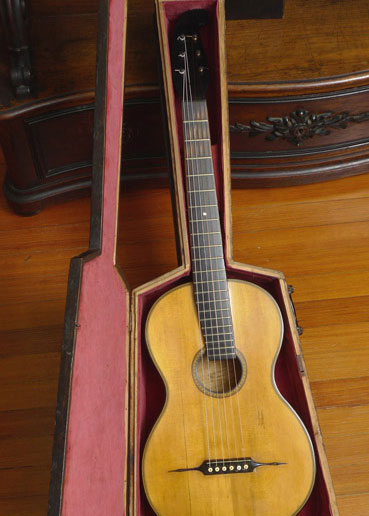 Read the full description below. If you're interested in this guitar, please call 512.922.8596 or contact us here.
Read the full description below. If you're interested in this guitar, please call 512.922.8596 or contact us here. -
 Very few modern luthiers have captured that Larson Brothers sustain and what I call “shimmer” with a new build. This guitar, built by the master luthier Hans Brentrup in late 2009, has it in spades. We’ve never played anything but a 30’s Larson Bros’ that has the sustain this guitar has. Hans’ unique tone bars do what only the Larson tone bar system did– get the body of the guitar to sustain and impart that wonderful shimmer to the trebles especially.
Very few modern luthiers have captured that Larson Brothers sustain and what I call “shimmer” with a new build. This guitar, built by the master luthier Hans Brentrup in late 2009, has it in spades. We’ve never played anything but a 30’s Larson Bros’ that has the sustain this guitar has. Hans’ unique tone bars do what only the Larson tone bar system did– get the body of the guitar to sustain and impart that wonderful shimmer to the trebles especially.- Brazilian Rosewood back and sides
- Engelmann spruce top
- 000 size
- 25.34 scale length
- Easily accommodates Medium or Heavy strings
- Hybrid ladder laminated bracing with Carbon fiber “Tone tubes”
- Mahogany neck
- Slotted headstock
- Golden Age tuners
- Ebony fingerboard with MOP dots
- Pyramid bridge
- Tortoise body binding
- Lacquer finish
-
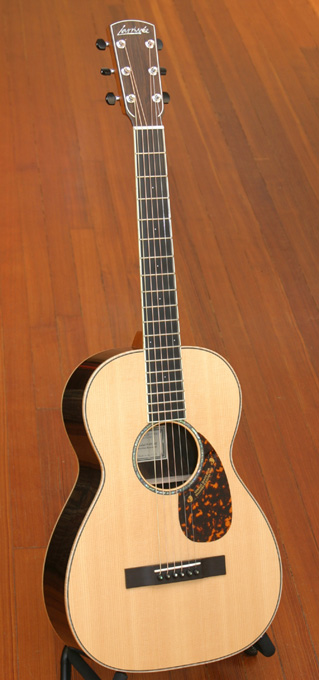 Mint condition. Period. Exceptional Larrivee 12-fret parlor guitar with a straight grained Sitka Spruce top and beautifully figured Brazilian Rosewood back & sides. Part of a very limited run of guitars built of high grade old stock Brazilian rosewood. Abalone rosette and tortoise shell pickguard. Ebony bridge w/ compensated saddle. Mahogany neck w/ microdot inlays, ivoroid bound ebony fingerboard, 1-3/4" nut, 24-1/4" scale, 13-1/4" lower bout, Larrivee logo peghead inlay, chrome tuners w/ebony buttons.
Mint condition. Period. Exceptional Larrivee 12-fret parlor guitar with a straight grained Sitka Spruce top and beautifully figured Brazilian Rosewood back & sides. Part of a very limited run of guitars built of high grade old stock Brazilian rosewood. Abalone rosette and tortoise shell pickguard. Ebony bridge w/ compensated saddle. Mahogany neck w/ microdot inlays, ivoroid bound ebony fingerboard, 1-3/4" nut, 24-1/4" scale, 13-1/4" lower bout, Larrivee logo peghead inlay, chrome tuners w/ebony buttons. -
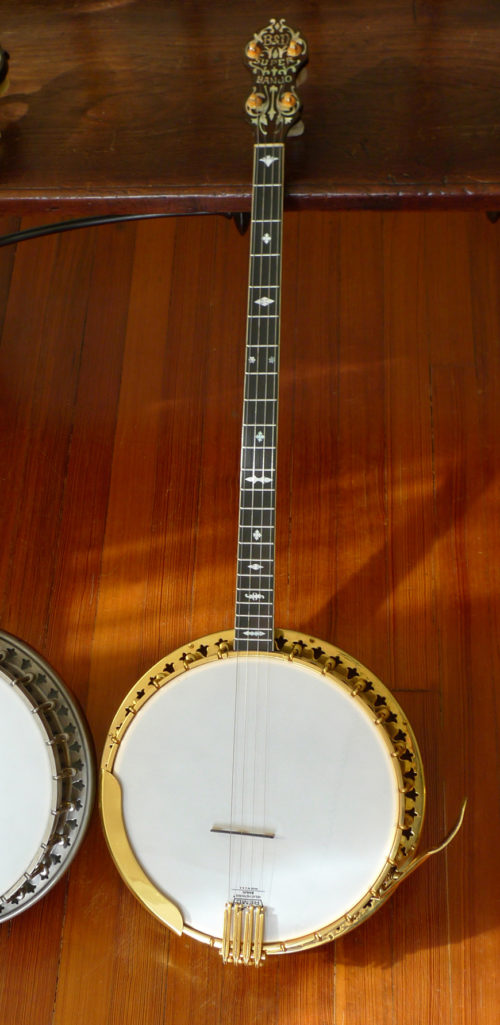 This rare 1926 example of Bacon & Day’s Super, Plectrum banjo is in wonderful condition– collectors quality, but it plays wonderfully. And this is the rare “Super” model A, gold plated. (All original, and with matching serial number on rim and dowel stick.) Original soft pedal stamped "Pat. Pend. B.&D. Soft Pedal." The original gold plating is in great condition, showing extremely little tarnishing, and no thin spots. In fact the banjo shows very little playwear at all. Original plectrum neck, original armrest– in fact all parts are original. Produced in the golden age of Bacon & Day (B&D) production, this banjo was made in Groton, CT. Although the earliest Bacon banjos were produced by various makers for Bacon from 1906-1920, the company’s best era began in 1922 when David Day left the Vega company to partner with Fred Bacon who had begun crafting his instruments in-house in 1920. The B&D banjos produced in this era are of considerably higher quality and are the sought after models by both players and collectors. The photos tell the story. 26 inch scale length. 22 fret plectrum 11″ rim In a recent hard shell case. ... no longer available ...
This rare 1926 example of Bacon & Day’s Super, Plectrum banjo is in wonderful condition– collectors quality, but it plays wonderfully. And this is the rare “Super” model A, gold plated. (All original, and with matching serial number on rim and dowel stick.) Original soft pedal stamped "Pat. Pend. B.&D. Soft Pedal." The original gold plating is in great condition, showing extremely little tarnishing, and no thin spots. In fact the banjo shows very little playwear at all. Original plectrum neck, original armrest– in fact all parts are original. Produced in the golden age of Bacon & Day (B&D) production, this banjo was made in Groton, CT. Although the earliest Bacon banjos were produced by various makers for Bacon from 1906-1920, the company’s best era began in 1922 when David Day left the Vega company to partner with Fred Bacon who had begun crafting his instruments in-house in 1920. The B&D banjos produced in this era are of considerably higher quality and are the sought after models by both players and collectors. The photos tell the story. 26 inch scale length. 22 fret plectrum 11″ rim In a recent hard shell case. ... no longer available ... -
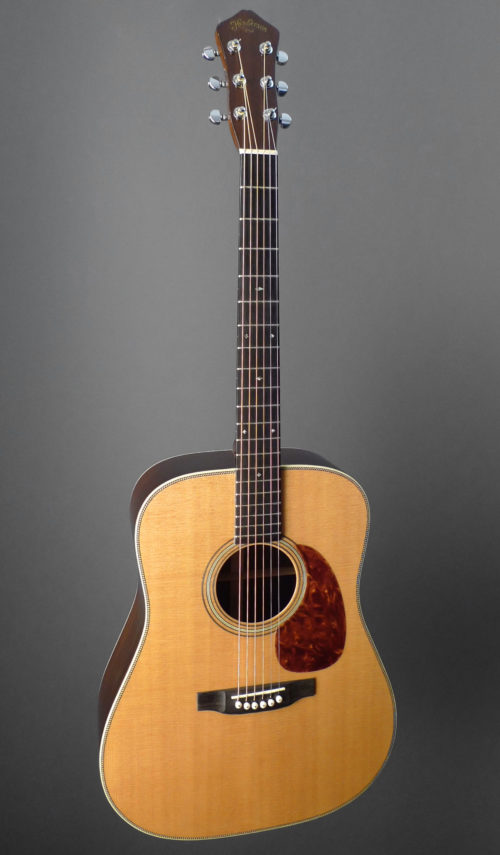 This week, to honor the just-announced winners of the 2018 Wayne Henderson Guitar Festival, we call out not an individual guitar, but rather one of the greatest American luthiers working today– and especially that luthier’s (and great player’s) work for youth in his area. We’re speaking of course of Wayne Henderson, and his legendary Festival. Every June Wayne Henderson hosts on of the most culturally important music festivals in the U.S., at the amphitheater in Grayson Highlands State Park near Henderson’s home and shop in Rugby, Virginia. The guitar- and generally music-loving attendees hear great music while supporting scholarships for young musicians in the area. And at the heart of the festival is the guitar competition. Click here to see the just-announced winners. And here’s a look at Fretboard Journal’s visit to the festival– and to Wayne Henderson’s luthier’s shop– a few years back. Click here for the article. .
This week, to honor the just-announced winners of the 2018 Wayne Henderson Guitar Festival, we call out not an individual guitar, but rather one of the greatest American luthiers working today– and especially that luthier’s (and great player’s) work for youth in his area. We’re speaking of course of Wayne Henderson, and his legendary Festival. Every June Wayne Henderson hosts on of the most culturally important music festivals in the U.S., at the amphitheater in Grayson Highlands State Park near Henderson’s home and shop in Rugby, Virginia. The guitar- and generally music-loving attendees hear great music while supporting scholarships for young musicians in the area. And at the heart of the festival is the guitar competition. Click here to see the just-announced winners. And here’s a look at Fretboard Journal’s visit to the festival– and to Wayne Henderson’s luthier’s shop– a few years back. Click here for the article. . -
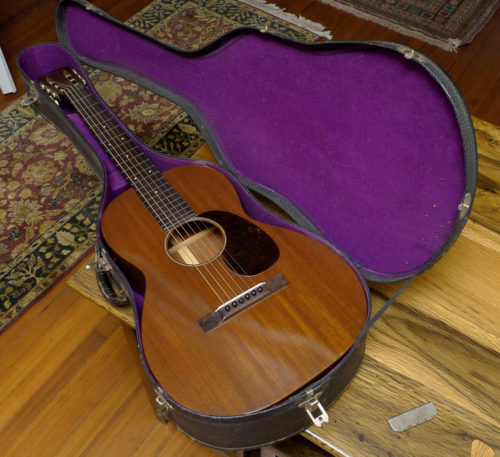 If there is a better-preserved Martin guitar from 1937, we have not seen it. This instrument is as an almost time-capsule condition 0-17H, still in its original case. And of course with its original Hawaiian set up. Many people convert these pre-war Martin Hawaiian set up guitars, to “Spanish” style, i.e. regular steel-string flat top set up. And that is certainly an option for whoever acquires this instrument. But this example, is just too nice, and too original for us to want to convert it. And the tone is exquisite (On request, we’ll send you a link to a video/audio clip of one of this country’s best, most famous dobro/pedal steel players playing slide on this great Martin 0-17H, right here in our shop.) All mahogany of course: mahogany back, sides, and top. Brazilian rosewood bridge, and fretboard. The guitar has no play wear. We won’t call it pristine– even under-the bed-guitars that have not really been played, have a few nicks from just being in the case and moved around a couple of times in 70+ years. But it’s as close to perfect as you’ll find in any 1930’s Martin. The neck is straight as an arrow, showing no bowing at all. No cracks of any kind. All original parts, period– down to the nut, bridge pins, and ivory saddle. The guitar is 12 fret to the body, unlike the regular 0-17’s from this period that were 14-fret.
If there is a better-preserved Martin guitar from 1937, we have not seen it. This instrument is as an almost time-capsule condition 0-17H, still in its original case. And of course with its original Hawaiian set up. Many people convert these pre-war Martin Hawaiian set up guitars, to “Spanish” style, i.e. regular steel-string flat top set up. And that is certainly an option for whoever acquires this instrument. But this example, is just too nice, and too original for us to want to convert it. And the tone is exquisite (On request, we’ll send you a link to a video/audio clip of one of this country’s best, most famous dobro/pedal steel players playing slide on this great Martin 0-17H, right here in our shop.) All mahogany of course: mahogany back, sides, and top. Brazilian rosewood bridge, and fretboard. The guitar has no play wear. We won’t call it pristine– even under-the bed-guitars that have not really been played, have a few nicks from just being in the case and moved around a couple of times in 70+ years. But it’s as close to perfect as you’ll find in any 1930’s Martin. The neck is straight as an arrow, showing no bowing at all. No cracks of any kind. All original parts, period– down to the nut, bridge pins, and ivory saddle. The guitar is 12 fret to the body, unlike the regular 0-17’s from this period that were 14-fret. -
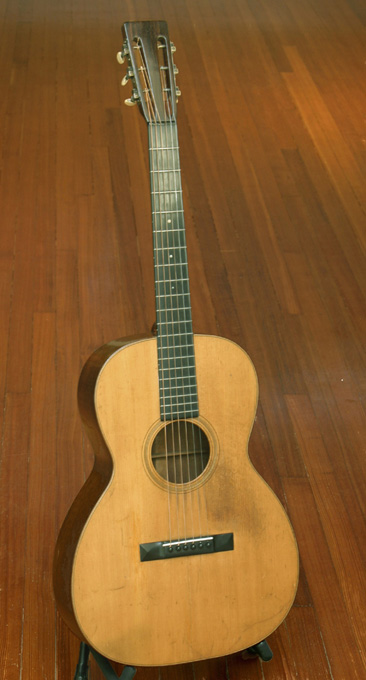 Take Martin’s best era for 12-fret guitars, add more scale length, and you get the best of both worlds–that’s what players say about the 000 sized 12-frets, if they can find one, from the mid to late 20’s. This was the biggest, loudest Martin made for steel strings in this era, with a 25.4 inch scale length, the same scale length as a 30’s D-45! (The 14-fret 000’s of the 30s and later have a shorter, 24.5 inch scale). In no other instrument will you get the resonance (from thin tops and back), combined with the long scale length. It’s a big pre-war Martin 12-fret. That’s why this instrument is a highly sought-after prewar Martin. This crack-free 000-18 has great provenance: acquired from and set up by one of the world’s top Martin experts (in Tuebingen, Germany). 1 7/8” nut. Mahogany back and sides. Adirondack spruce top. Ebony fingerboard. It has original tuners (gear wheel below worm gear, ivoroid buttons), parts, and all original finish. Restoration by TJ Thompson and Dana Bourgeois: correct replacement bridge (ebony pyramid) and bridge plate (maple), and frets replaced (bar frets). Center seam repaired and cleated and touched up (shellack). Neck has been reset. Neck is dead straight, bridge saddle is medium height (allows set up for both higher and lower action if needed in future). Low action, and set up for light or medium gauge strings. The tone could not be better: all the clear separation of the mids that is the hallmark of the 20’s style 18 twelve-fret, but with fuller, louder, rounder bass. One of the most sought-after Martin 12-frets, original finish, crack-free. Restored correctly, cared for, and set up by the world’s best luthiers and vintage Martin experts, and ready to enjoy.
Take Martin’s best era for 12-fret guitars, add more scale length, and you get the best of both worlds–that’s what players say about the 000 sized 12-frets, if they can find one, from the mid to late 20’s. This was the biggest, loudest Martin made for steel strings in this era, with a 25.4 inch scale length, the same scale length as a 30’s D-45! (The 14-fret 000’s of the 30s and later have a shorter, 24.5 inch scale). In no other instrument will you get the resonance (from thin tops and back), combined with the long scale length. It’s a big pre-war Martin 12-fret. That’s why this instrument is a highly sought-after prewar Martin. This crack-free 000-18 has great provenance: acquired from and set up by one of the world’s top Martin experts (in Tuebingen, Germany). 1 7/8” nut. Mahogany back and sides. Adirondack spruce top. Ebony fingerboard. It has original tuners (gear wheel below worm gear, ivoroid buttons), parts, and all original finish. Restoration by TJ Thompson and Dana Bourgeois: correct replacement bridge (ebony pyramid) and bridge plate (maple), and frets replaced (bar frets). Center seam repaired and cleated and touched up (shellack). Neck has been reset. Neck is dead straight, bridge saddle is medium height (allows set up for both higher and lower action if needed in future). Low action, and set up for light or medium gauge strings. The tone could not be better: all the clear separation of the mids that is the hallmark of the 20’s style 18 twelve-fret, but with fuller, louder, rounder bass. One of the most sought-after Martin 12-frets, original finish, crack-free. Restored correctly, cared for, and set up by the world’s best luthiers and vintage Martin experts, and ready to enjoy. -
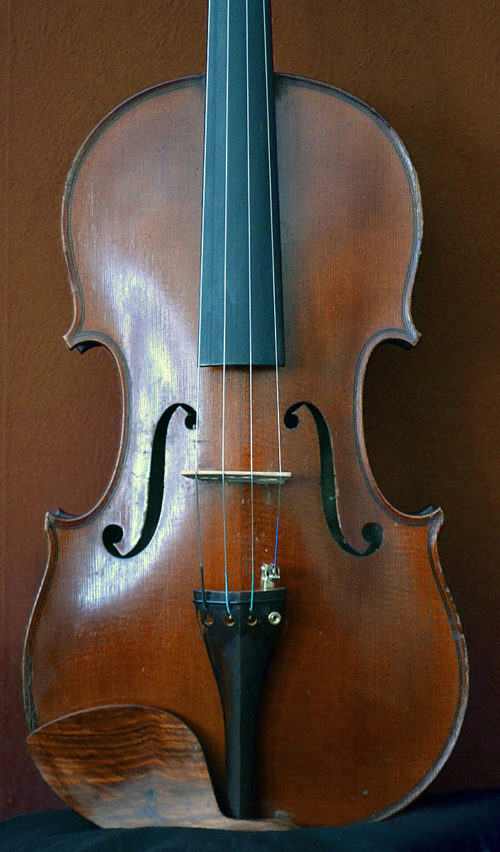 Full size, Charles Fetique violin (French, early 20th century – circa 1930), with original label inside. This is a rich, sonorous instrument. A deep, round tone, that – like all good violins – does not make you work overly hard to attain. It has a darker, lush, round tone that professional players love – and great projection. We recently A-B'd this instrument against $5k+ violins in the area, and there was no comparison, this instrument was louder, more full, more round and full in the bass notes, and all around a stellar performer. This violin would be a great student violin upgrade – for that aspiring violinist who is ready to graduate to, and enjoy, a better instrument than what's typically available in the $4-5K range, at a very attractive price. And, the buyer will have the confidence of both a Letter of Expertise, and a professional appraisal: • Certificate: Jean-Jacques Rampal, Paris, 2014. (This is the letter of expertise, on this violin, from one of the top experts on French Violins, in Paris, France). And: • Written, professional appraisal of the violin, done from personal inspection, from one of the top violin shops/experts in Texas (Jay R. Rury Violins, Dallas), with a valuation of $3,500.00 Both the above documents will be included with the sale. The violin is in excellent condition. There are no sound post, or bass bar cracks. It was professionally set up to play, by Blackerby Violin in Austin. In a modern Tonerelli case. Price: $3250.
Full size, Charles Fetique violin (French, early 20th century – circa 1930), with original label inside. This is a rich, sonorous instrument. A deep, round tone, that – like all good violins – does not make you work overly hard to attain. It has a darker, lush, round tone that professional players love – and great projection. We recently A-B'd this instrument against $5k+ violins in the area, and there was no comparison, this instrument was louder, more full, more round and full in the bass notes, and all around a stellar performer. This violin would be a great student violin upgrade – for that aspiring violinist who is ready to graduate to, and enjoy, a better instrument than what's typically available in the $4-5K range, at a very attractive price. And, the buyer will have the confidence of both a Letter of Expertise, and a professional appraisal: • Certificate: Jean-Jacques Rampal, Paris, 2014. (This is the letter of expertise, on this violin, from one of the top experts on French Violins, in Paris, France). And: • Written, professional appraisal of the violin, done from personal inspection, from one of the top violin shops/experts in Texas (Jay R. Rury Violins, Dallas), with a valuation of $3,500.00 Both the above documents will be included with the sale. The violin is in excellent condition. There are no sound post, or bass bar cracks. It was professionally set up to play, by Blackerby Violin in Austin. In a modern Tonerelli case. Price: $3250. -
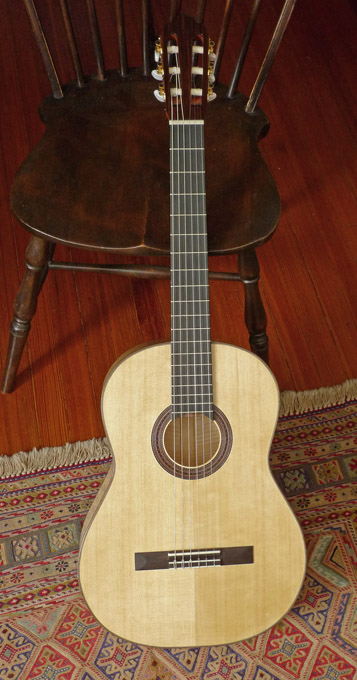 Joseph Redman, based in Abingdon, VA, makes some nice, hand made, yet affordable classical and flamenco guitars. Their low price tags don’t reflect the quality of materials in each instrument. This was a custom order, featuring European Maple back and sides, and all hand French polished by Redman. Nice, rumbling bass response. The Maple tone here, doesn’t show up in the trebles as much as it does in the bass– adding a Maple crispness to the bass strings.
Joseph Redman, based in Abingdon, VA, makes some nice, hand made, yet affordable classical and flamenco guitars. Their low price tags don’t reflect the quality of materials in each instrument. This was a custom order, featuring European Maple back and sides, and all hand French polished by Redman. Nice, rumbling bass response. The Maple tone here, doesn’t show up in the trebles as much as it does in the bass– adding a Maple crispness to the bass strings.- Finish: hand-rubbed French Polish
- 650mm Scale length
- European Maple back and sides
- Canadian Spruce top
- Ebony fretboard
- Neck: Spanish Cedar
- Bindings:
-
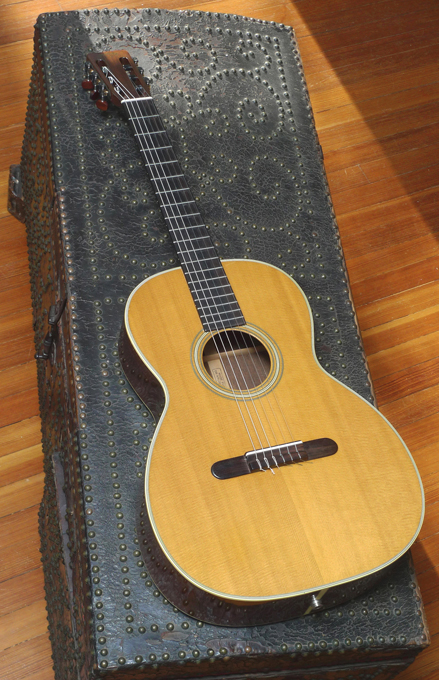 A wonderfully preserved, crack free 12 fret 000-28 Martin, with gorgeous Brazilian rosewood back and sides. The tone of this instrument is wonderful. It stands up to many high end Spanish made classical guitars of the period for Brazilian rosewood warmth. While intentionally not built for concert hall volume, the bass tone and clarity of the trebles on large-bodied Martin nylon strings guitars with Brazilian back and sides is unsurpassed. This instrument is very well set up to play on stage, plugged in, and to record, if desired. It has great high end Gilbert tuners, with black housing, abalone dot and snakewood buttons. (Original tuners, in perfect condition, are in the case, so you can easily replace the originals if desired.) This instrument has an excellent custom engineered stereo pickup system, installed without altering the guitar: The pickup is the undersaddle type, supplied by EMG. The separate mic element is assembled in a foam mounting block with cable, endpin jack, custom made for this guitar. It is unobtrusive in its mounting. Jack is mounted in the endpin hole, so there are no extra holes in the guitar. The output jack is stereo, TRS (Tip wired to pickup, Ring wired to mic, and Sleeve is ground.) The addition of the internal mic adds a realism and depth that no pickup by itself can capture. The EMG pickup is excellent compared to most others in terms of exhibiting less of that harsh piezo sound. The result is a guitar that plays beautifully amplified, or on its own. The Martin “C” has the old elongated Martin 12 fret body. It was offered in the 00-16C, 00-18C and 000-28C in 1962. 1966 saw the last 000-28C. There were not many nylon string, 000-sized 28 models made, and fewer still with the quality of Brazilian rosewood this one has. And the condition on this instrument is stunning. No cracks anywhere, and very little wear at all.
A wonderfully preserved, crack free 12 fret 000-28 Martin, with gorgeous Brazilian rosewood back and sides. The tone of this instrument is wonderful. It stands up to many high end Spanish made classical guitars of the period for Brazilian rosewood warmth. While intentionally not built for concert hall volume, the bass tone and clarity of the trebles on large-bodied Martin nylon strings guitars with Brazilian back and sides is unsurpassed. This instrument is very well set up to play on stage, plugged in, and to record, if desired. It has great high end Gilbert tuners, with black housing, abalone dot and snakewood buttons. (Original tuners, in perfect condition, are in the case, so you can easily replace the originals if desired.) This instrument has an excellent custom engineered stereo pickup system, installed without altering the guitar: The pickup is the undersaddle type, supplied by EMG. The separate mic element is assembled in a foam mounting block with cable, endpin jack, custom made for this guitar. It is unobtrusive in its mounting. Jack is mounted in the endpin hole, so there are no extra holes in the guitar. The output jack is stereo, TRS (Tip wired to pickup, Ring wired to mic, and Sleeve is ground.) The addition of the internal mic adds a realism and depth that no pickup by itself can capture. The EMG pickup is excellent compared to most others in terms of exhibiting less of that harsh piezo sound. The result is a guitar that plays beautifully amplified, or on its own. The Martin “C” has the old elongated Martin 12 fret body. It was offered in the 00-16C, 00-18C and 000-28C in 1962. 1966 saw the last 000-28C. There were not many nylon string, 000-sized 28 models made, and fewer still with the quality of Brazilian rosewood this one has. And the condition on this instrument is stunning. No cracks anywhere, and very little wear at all. -
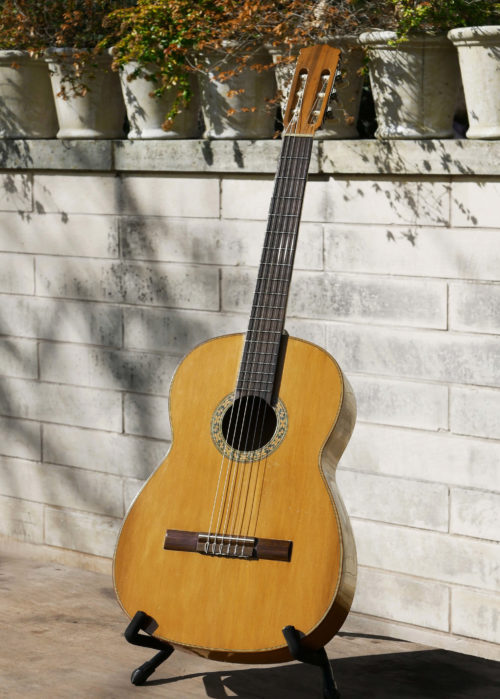 Another instrument from Enos Hernandez of Mexico, one of the best luthiers to ever live in work in Mexico, circa 1970’s. This one is a flamenco Blanca, with the classic cypress back and sides. Like the other Enos Hernandez we have, this one also has a cedar top. The instrument is super light weight, as a Flamenco Blanca should be, and it’s bright and percussive and raspy as a good Blanca should be. There is a scratch (not a crack) on back of guitar (see photo). There are dot position markers – original to the guitar, i.e. not added later – on top edge of fretboard (frets 3,5,7,9 – see photo). Scale length: 660mm Available January 2018 Price: $2950
Another instrument from Enos Hernandez of Mexico, one of the best luthiers to ever live in work in Mexico, circa 1970’s. This one is a flamenco Blanca, with the classic cypress back and sides. Like the other Enos Hernandez we have, this one also has a cedar top. The instrument is super light weight, as a Flamenco Blanca should be, and it’s bright and percussive and raspy as a good Blanca should be. There is a scratch (not a crack) on back of guitar (see photo). There are dot position markers – original to the guitar, i.e. not added later – on top edge of fretboard (frets 3,5,7,9 – see photo). Scale length: 660mm Available January 2018 Price: $2950 -

-
 This extraordinary guitar, completed by C.T. Beitel in June of 1894, is signed and dated by him on the underside of the top. The guitar is in remarkably original condition. And it plays wonderfully. C.T. Beitel (Clemence T. Beitel, 1869-1916) was closely associated with C.F. Martin & Co. in the 1890’s. The Beitels are well known to have been closely associated with the Martin family in these years, both personally (including through marriage) and in the Martin guitar business. According to some correspondence and background research from family members obtained with this guitar, C.T. Beitel was the first American-born person to serve an apprenticeship at Martin Guitars. C.T. Beitel was a cousin to C.A. Zoebisch– who was of course the famous Martin guitar distributor and sometimes-partner of C.F. Martin & Co. in this period. Although this guitar is strikingly faithful to Martin specs, this is most likely one of C.T. Beitel’s guitars made by him to market separately from Martin. It is documented that at least one of the Beitel family had an ongoing guitar making and marketing business in the late 1890’s. Is this Beitel guitar one of the first made under the “Beitel” name? Certainly. Are there others remaining today? There are none known of by us–making this a rare and highly collectible guitar. Similar to a Martin 2-27… but not exactly. More like a cross between a 2-27, a “28” style–because of the wonderful Herringbone purfling/binding on the top– and a 30’s or higher style with its very fancy Jerome tuners.
This extraordinary guitar, completed by C.T. Beitel in June of 1894, is signed and dated by him on the underside of the top. The guitar is in remarkably original condition. And it plays wonderfully. C.T. Beitel (Clemence T. Beitel, 1869-1916) was closely associated with C.F. Martin & Co. in the 1890’s. The Beitels are well known to have been closely associated with the Martin family in these years, both personally (including through marriage) and in the Martin guitar business. According to some correspondence and background research from family members obtained with this guitar, C.T. Beitel was the first American-born person to serve an apprenticeship at Martin Guitars. C.T. Beitel was a cousin to C.A. Zoebisch– who was of course the famous Martin guitar distributor and sometimes-partner of C.F. Martin & Co. in this period. Although this guitar is strikingly faithful to Martin specs, this is most likely one of C.T. Beitel’s guitars made by him to market separately from Martin. It is documented that at least one of the Beitel family had an ongoing guitar making and marketing business in the late 1890’s. Is this Beitel guitar one of the first made under the “Beitel” name? Certainly. Are there others remaining today? There are none known of by us–making this a rare and highly collectible guitar. Similar to a Martin 2-27… but not exactly. More like a cross between a 2-27, a “28” style–because of the wonderful Herringbone purfling/binding on the top– and a 30’s or higher style with its very fancy Jerome tuners.- No “Martin” stamps anywhere
- “C.T. Beitel” paper label on neck block (Martin stamp beneath the label? Uncertain)
- Signed and dated on underside of top: “C.T. Beitel, 6/94, Easton” (i.e. Easton, PA)
- X-braced top
- All original finish; no touch-ups etc
- Pearl inlay around sound hole
- Herringbone purfling around top
- Real Ivory binding, top, and back
- Bound Ivory neck
- Ebony bridge
- Ebony fretboard (bound in Ivory)
- Original Maple bridge plate
- Size: a just bit bigger at lower bout than a Martin “2” size: 12 1/4 inches
- Scale length: 24 3/4 inches
- Body length: 18 3/8 inches
- String spacing at bridge: 2 3/8 inches - Nut width: 1 7/8 inches
- Body depth at bottom of guitar: 4 inches
- Top: Adirondack Spruce
- Back and sides: solid Brazilian Rosewood
- Neck: Cedar
- Headstock: Brazilian Rosewood veneer
- Tuners: original, German-made Jerome tuners, with fancy flower engraving, and oval shaped Ivory tuner buttons. These tuners are typically found only on the highest model Martin guitars of those years
- Tuner buttons: Ivory, oval-shaped
-
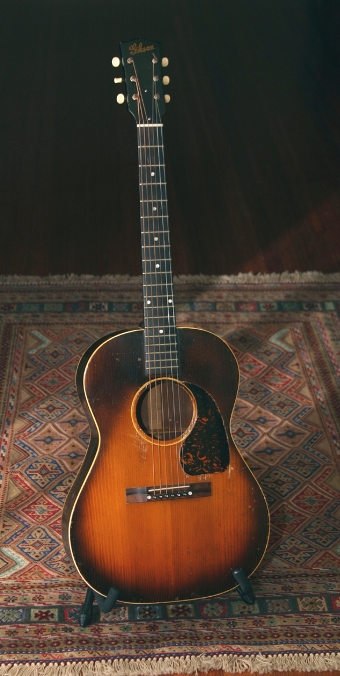 (No serial number or FON, these years often do not have one.) This completely crack-free, Script logo LG-2 is a jewel. A lot of players say the script logo Gibsons from right after the war are better sounding and better-built guitars than the Banner Gibsons. All of the good things about Banners, but with better craftsmanship. All original finish, everywhere. Mahogany back and sides. Spruce top. Not a crack anywhere. 1-3/4" nut. The bridge is an excellent quality rosewood replacement. Original maple plate. Original tuners. Replaced nut and saddle. Rosewood fingerboard shows moderate wear on first couple of frets. Some of that wonderful Gibson 40’s crazing to the finish, but not at all out of hand. Various pick marks, and dings. Original tuners, bridge, plate. Piezo pickup was skillfully de-installed, and endpin jack removed and plugged. One of the finest Script logo LG-2s you’ll find.
(No serial number or FON, these years often do not have one.) This completely crack-free, Script logo LG-2 is a jewel. A lot of players say the script logo Gibsons from right after the war are better sounding and better-built guitars than the Banner Gibsons. All of the good things about Banners, but with better craftsmanship. All original finish, everywhere. Mahogany back and sides. Spruce top. Not a crack anywhere. 1-3/4" nut. The bridge is an excellent quality rosewood replacement. Original maple plate. Original tuners. Replaced nut and saddle. Rosewood fingerboard shows moderate wear on first couple of frets. Some of that wonderful Gibson 40’s crazing to the finish, but not at all out of hand. Various pick marks, and dings. Original tuners, bridge, plate. Piezo pickup was skillfully de-installed, and endpin jack removed and plugged. One of the finest Script logo LG-2s you’ll find. -
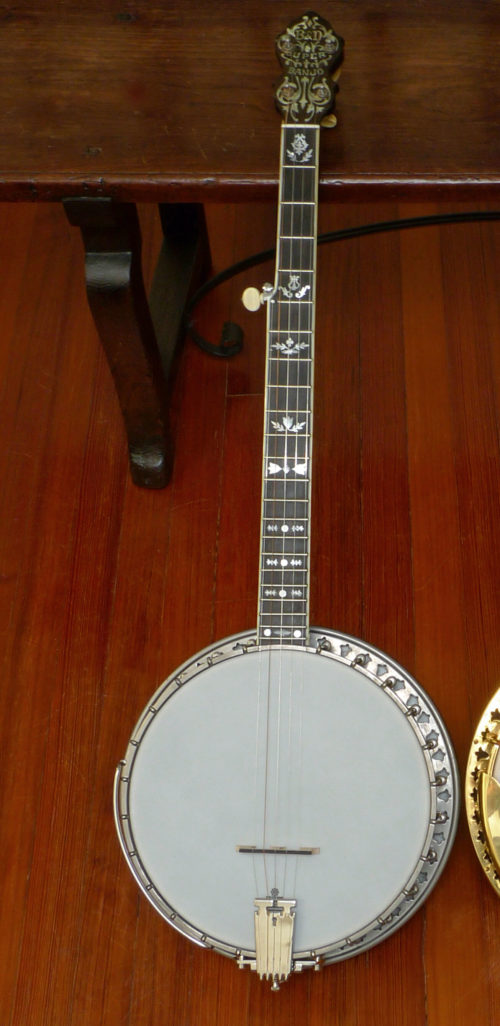 This is a superb sounding 5 string banjo. Original nickel plating. • Bacon & Day Super, 5-string Banjo (Style A) Serial number: 25892 (early 1928) • Resonator, stamped on inside (in nickel-laminated maple): Bacon Banjo Co., Inc. Groton, CT. U.S.A. Dec. 20th, 1927 • Conversion, 5 string neck (original neck was probably a tenor or plectrum); Presumably, this neck is newer than the banjo– yet the advanced MOP fret markers are as found on the earliest versions of B&D Super banjos. We assume this neck was built by one of the best U.S. “conversion” builders – with a re-use of the original MOP inlay at the peghead plus the dowel stick. Maple neck, with steel reinforcing rod. Fretboard is beautiful jet-black ebony; multi-layer neck bindings. Fretboard is a very comfortable 1 3/8 inches wide at the nut, 1 7/8 wide where fretboard meets body. • Nickel plated • 22 frets • Scale length: 27 inches • Extended Maple resonator– nickel laminated on inside • Original flat Tulip-hole flange (not the “add-on” round-hole resonator of earlier years). • Original, top of the line Type III Silver Bell tone ring (No Hole tone ring) original to the instrument (this is the most sought-after, advanced Silver Bell tone ring, introduced early 1927). • Original 2 band Grover geared tuning pegs • Fults tailpiece, and included a variety of Fults tone pins. Bob Fults made the best tailpieces available. And his tone pins let you tweak the tone of your banjo. There are several interchangeable Fults pins included here– ivory, ebony, lead, sterling silver, brass, and copper. Plus a “tone lock”. (Bob Fults recently retired, and these highly sought after Fults tailpieces and pins are no longer available.) In its original hard shell Lifton case. $3750.
This is a superb sounding 5 string banjo. Original nickel plating. • Bacon & Day Super, 5-string Banjo (Style A) Serial number: 25892 (early 1928) • Resonator, stamped on inside (in nickel-laminated maple): Bacon Banjo Co., Inc. Groton, CT. U.S.A. Dec. 20th, 1927 • Conversion, 5 string neck (original neck was probably a tenor or plectrum); Presumably, this neck is newer than the banjo– yet the advanced MOP fret markers are as found on the earliest versions of B&D Super banjos. We assume this neck was built by one of the best U.S. “conversion” builders – with a re-use of the original MOP inlay at the peghead plus the dowel stick. Maple neck, with steel reinforcing rod. Fretboard is beautiful jet-black ebony; multi-layer neck bindings. Fretboard is a very comfortable 1 3/8 inches wide at the nut, 1 7/8 wide where fretboard meets body. • Nickel plated • 22 frets • Scale length: 27 inches • Extended Maple resonator– nickel laminated on inside • Original flat Tulip-hole flange (not the “add-on” round-hole resonator of earlier years). • Original, top of the line Type III Silver Bell tone ring (No Hole tone ring) original to the instrument (this is the most sought-after, advanced Silver Bell tone ring, introduced early 1927). • Original 2 band Grover geared tuning pegs • Fults tailpiece, and included a variety of Fults tone pins. Bob Fults made the best tailpieces available. And his tone pins let you tweak the tone of your banjo. There are several interchangeable Fults pins included here– ivory, ebony, lead, sterling silver, brass, and copper. Plus a “tone lock”. (Bob Fults recently retired, and these highly sought after Fults tailpieces and pins are no longer available.) In its original hard shell Lifton case. $3750. -
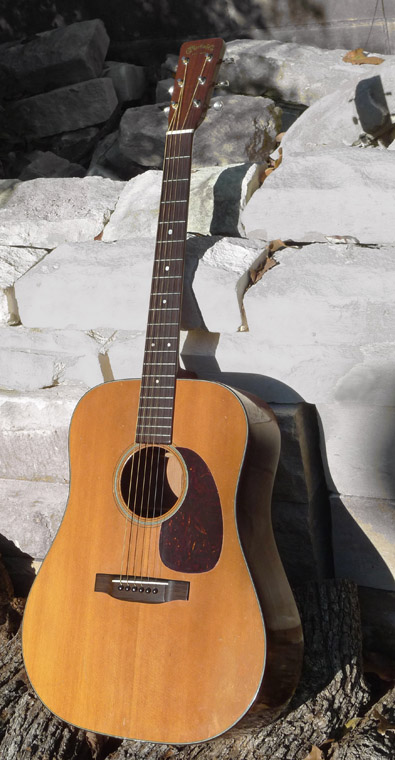 This is another great mid-fifties dread in unbelievable condition. It’s totally crack-free (also, not even a “pick guard” crack). Was acquired in 100% original condition: bridge, saddle, bridge pins, tuners, everything. Just had a neck set– resulting in great action, and tone/projection. With new condition Martin hard shell case.
This is another great mid-fifties dread in unbelievable condition. It’s totally crack-free (also, not even a “pick guard” crack). Was acquired in 100% original condition: bridge, saddle, bridge pins, tuners, everything. Just had a neck set– resulting in great action, and tone/projection. With new condition Martin hard shell case. -
Out of stock
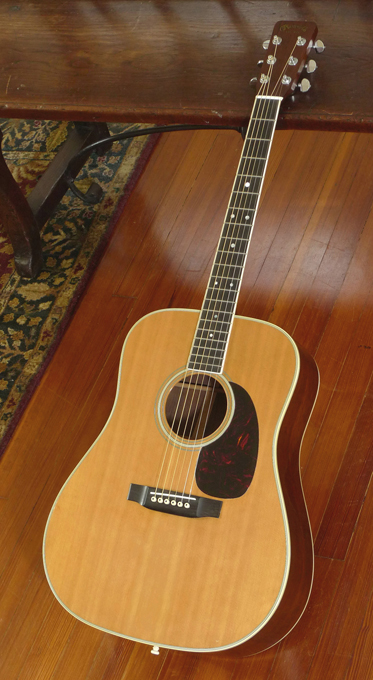 If there is a mid-60’s Brazilian Rosewood D-35 in better original condition out there than this one– it would have to be new. About as close to mint as you can get, this guitar shows little wear. And the Brazilian on back and sides– wonderful specimens, not the “figured” stuff you see on many later 60’s Martins. Not a crack, or hint of crack, anywhere (no, not even the typical “pickguard” crack). Original bridge, tuners, etc. Original frets show almost no wear. All original finish everywhere–and note that the finish does not have any of that “crazing” you often see on the original finishes of mid-60’s Martins. It has never had strap lugs attached. It has the more desirable original tortoise pickguard (Martin changed to black pickguards, later in 1967). Original small maple bridge plate, in original condition. The tone of this guitar, is wonderful. Ringing trebles like the very best brazilian Martin dread’s. And a bass response that shows why Martin brought out this model, in 1965, as an even higher-end model (and with lighter bracing) than the D-28. There are few tiny dings near the edge of the lower bout, on top (too small to photograph well). But a D-35 in better condition than this one would have to be off the factory floor. Action is perfect. Neck straight. Ready to play.
If there is a mid-60’s Brazilian Rosewood D-35 in better original condition out there than this one– it would have to be new. About as close to mint as you can get, this guitar shows little wear. And the Brazilian on back and sides– wonderful specimens, not the “figured” stuff you see on many later 60’s Martins. Not a crack, or hint of crack, anywhere (no, not even the typical “pickguard” crack). Original bridge, tuners, etc. Original frets show almost no wear. All original finish everywhere–and note that the finish does not have any of that “crazing” you often see on the original finishes of mid-60’s Martins. It has never had strap lugs attached. It has the more desirable original tortoise pickguard (Martin changed to black pickguards, later in 1967). Original small maple bridge plate, in original condition. The tone of this guitar, is wonderful. Ringing trebles like the very best brazilian Martin dread’s. And a bass response that shows why Martin brought out this model, in 1965, as an even higher-end model (and with lighter bracing) than the D-28. There are few tiny dings near the edge of the lower bout, on top (too small to photograph well). But a D-35 in better condition than this one would have to be off the factory floor. Action is perfect. Neck straight. Ready to play. -
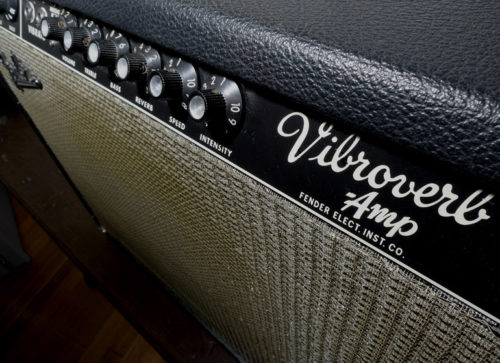 The blackface Vibroverb may be the most sought after Fender amp of all time. Stevie Ray Vaughan is famous for using them. The Vibroverb started as a 2x10 combo with reverb in '63. Then in late '63, Fender decided to switch to a 1x15. This amp has incredible tone. One must hear a black face circuit through an open cabinet JBL 15" speaker to understand the sound. It sounds big and can fill the hall, but it can work as a mid size amp perfect for gigs. This amp is versatile, since the JBL D130 can carry the treble of a telecaster or strat while still having a strong bottom end. Most other amps are either good on highs (Vibrolux, Princeton, Champ), good on lows (Twin, Showman), midrangy (Deluxe, and most new amps) or too big (Marshall double stack). The great Vibroverb is superior to them all. This 1964 Blackface Vibroverb has the original JBL speaker, and the original transformer. The amp also comes with its original footswitch. The only thing done to the amp has been replaced tubes, and the caps. The power cord has been replaced with a grounded three-prong cord.
The blackface Vibroverb may be the most sought after Fender amp of all time. Stevie Ray Vaughan is famous for using them. The Vibroverb started as a 2x10 combo with reverb in '63. Then in late '63, Fender decided to switch to a 1x15. This amp has incredible tone. One must hear a black face circuit through an open cabinet JBL 15" speaker to understand the sound. It sounds big and can fill the hall, but it can work as a mid size amp perfect for gigs. This amp is versatile, since the JBL D130 can carry the treble of a telecaster or strat while still having a strong bottom end. Most other amps are either good on highs (Vibrolux, Princeton, Champ), good on lows (Twin, Showman), midrangy (Deluxe, and most new amps) or too big (Marshall double stack). The great Vibroverb is superior to them all. This 1964 Blackface Vibroverb has the original JBL speaker, and the original transformer. The amp also comes with its original footswitch. The only thing done to the amp has been replaced tubes, and the caps. The power cord has been replaced with a grounded three-prong cord. -
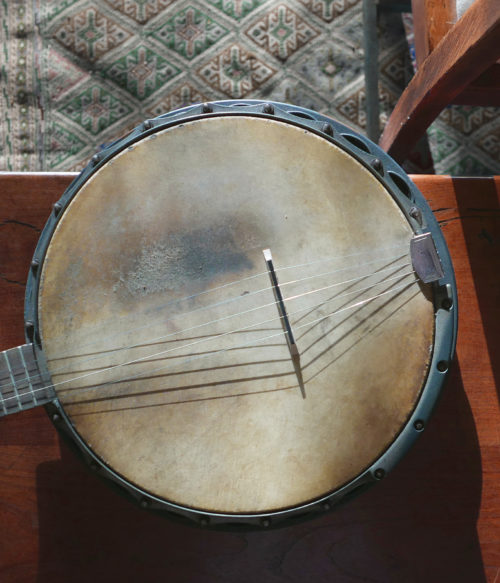 This Banjo has a unique tone, that only comes from a Gretsch Die-cast metal shell/flange construction, prewar banjo. But it’s rare to see these banjos in anything other than tenor. This one is a rare, original 5 string configuration, and has a nice “Gretsch growl” (a term that some drummers use to describe Gretsch drums). Wonderful, dark tone, with bell-like high notes. And with a bit of sustain that is reminiscent of a prewar Dobro guitar. Growl, plus sustain, and ringing highs – only from a Gretsch prewar banjo. Pearloid heastock overlay. 11 inch head. 26 inch scale length. 22-fret Brazilian rosewood fingerboard, with dot markers. Walnut neck, and resonator. Top tension head adjustment with 20 lugs. Original calf skin head. Price: $750.
This Banjo has a unique tone, that only comes from a Gretsch Die-cast metal shell/flange construction, prewar banjo. But it’s rare to see these banjos in anything other than tenor. This one is a rare, original 5 string configuration, and has a nice “Gretsch growl” (a term that some drummers use to describe Gretsch drums). Wonderful, dark tone, with bell-like high notes. And with a bit of sustain that is reminiscent of a prewar Dobro guitar. Growl, plus sustain, and ringing highs – only from a Gretsch prewar banjo. Pearloid heastock overlay. 11 inch head. 26 inch scale length. 22-fret Brazilian rosewood fingerboard, with dot markers. Walnut neck, and resonator. Top tension head adjustment with 20 lugs. Original calf skin head. Price: $750. -
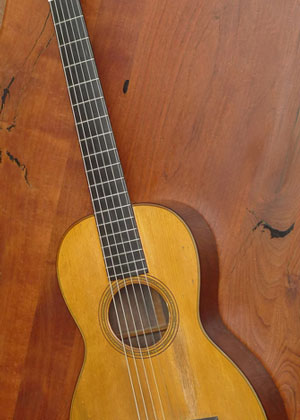 Considered by many to be most charming, intimate, 19th century Martin parlor guitar, the Martin 3-17 features Brazilian Rosewood back and sides, Adirondack spruce top, and Jerome tuners. This particular instrument, with an unbelievably beautiful, lyrical voice, was made in the early 1850’s, as we can tell by several clues. It’s a lot like Mark Twain’s famous Martin 2 ½-17 (see photo). Of course, it has to have the “CF Martin New York” not “CF Martin & Co” stamps– as this one does, to make it a pre-1867 Martin. Also, according to Martin scholars, Jerome tuners seem to have faded out by the late 1850s, to be replaced with similar tuners with a shorter plate and no name stamp. It is unusual on this guitar that the Jerome tuners are German silver, as most of the style 17 guitars have brass tuners. With the “tulip-shaped” tuner buttons, experts date the guitar to the early 1850s. The top is fan braced. Measurements are: body length 17.25″, lower bout width 11.125″, upper bout width 8.25″, overall length 35.75″, scale length just shy of 24 inches. 12 fret cedar neck with ice cream cone heel. Note that the black paint on the back of the neck and back of headstock was removed in some previous century– that does give a nice look at the cedar that would normally be obscured by the black “ebonized” paint. The body of the guitar had some overspray, but it turned out go be one of those fortunate occasions where it was light and really just sitting on top of the original finish, so we are able to easily remove it and reveal the original finish. A couple of small hairline cracks in back, repaired. Top and sides are crack-free. Reproduction ebony bridge. Original bar frets. Original Jerome Silver tuners, with original buttons. Original bracing and bridge plate. “C.F. MARTIN / NEW YORK” hot stamped on back, inside back brace and heel block (but the back stamp is faded). A previous owner of this guitar had a custom hard shell case made– it’s a professional quality, premium case that protects the guitar quite well– it’s heavy and sturdier than most new expensive hard shell cases. Historical interest aside (pre-civil war Martin guitars are rare), this guitar plays wonderfully. It projects the sweetest, but robust, glassy trebles, and clear mids and bass notes. It’s just a joy to play, and it just floats in your hands. (Note: 19th century Martins can be fitted with: gut strings, classical guitar strings, or extra light steel strings– depending on the guitar. It’s really a case-by-case basis, determining whether a particular 19th century Martin can “hold” or “withstand” very light gauge steel strings for example. One size does not fit all. And different 19th century Martins sound better with different strings. In this case, with this particular guitar, extra light steel strings are perfect. It can hold them fine– due to the structure of the top, the bridge plate, and bridge. And it plays and sounds perfect with those strings. This guitar is real find in that regard– not for the collector’s wall but for the player who wants to experience what the original CF Martin felt when he held this instrument in his hands in Nazareth, Pennsylvania, when Abraham Lincoln had not the slightest inkling he’d be in the White House and was just forging a reputation as an outstanding lawyer and earning the nickname of ‘Honest Abe’, and the New York Times was just commencing operations, and the first oil well had just been drilled in the United States by “Colonel” Edwin Drake in Titusville, Pennsylvania– that despite being in C.F. Martin’s state was darn near the old west at the time. In a custom made, professional quality hard shell case.
Considered by many to be most charming, intimate, 19th century Martin parlor guitar, the Martin 3-17 features Brazilian Rosewood back and sides, Adirondack spruce top, and Jerome tuners. This particular instrument, with an unbelievably beautiful, lyrical voice, was made in the early 1850’s, as we can tell by several clues. It’s a lot like Mark Twain’s famous Martin 2 ½-17 (see photo). Of course, it has to have the “CF Martin New York” not “CF Martin & Co” stamps– as this one does, to make it a pre-1867 Martin. Also, according to Martin scholars, Jerome tuners seem to have faded out by the late 1850s, to be replaced with similar tuners with a shorter plate and no name stamp. It is unusual on this guitar that the Jerome tuners are German silver, as most of the style 17 guitars have brass tuners. With the “tulip-shaped” tuner buttons, experts date the guitar to the early 1850s. The top is fan braced. Measurements are: body length 17.25″, lower bout width 11.125″, upper bout width 8.25″, overall length 35.75″, scale length just shy of 24 inches. 12 fret cedar neck with ice cream cone heel. Note that the black paint on the back of the neck and back of headstock was removed in some previous century– that does give a nice look at the cedar that would normally be obscured by the black “ebonized” paint. The body of the guitar had some overspray, but it turned out go be one of those fortunate occasions where it was light and really just sitting on top of the original finish, so we are able to easily remove it and reveal the original finish. A couple of small hairline cracks in back, repaired. Top and sides are crack-free. Reproduction ebony bridge. Original bar frets. Original Jerome Silver tuners, with original buttons. Original bracing and bridge plate. “C.F. MARTIN / NEW YORK” hot stamped on back, inside back brace and heel block (but the back stamp is faded). A previous owner of this guitar had a custom hard shell case made– it’s a professional quality, premium case that protects the guitar quite well– it’s heavy and sturdier than most new expensive hard shell cases. Historical interest aside (pre-civil war Martin guitars are rare), this guitar plays wonderfully. It projects the sweetest, but robust, glassy trebles, and clear mids and bass notes. It’s just a joy to play, and it just floats in your hands. (Note: 19th century Martins can be fitted with: gut strings, classical guitar strings, or extra light steel strings– depending on the guitar. It’s really a case-by-case basis, determining whether a particular 19th century Martin can “hold” or “withstand” very light gauge steel strings for example. One size does not fit all. And different 19th century Martins sound better with different strings. In this case, with this particular guitar, extra light steel strings are perfect. It can hold them fine– due to the structure of the top, the bridge plate, and bridge. And it plays and sounds perfect with those strings. This guitar is real find in that regard– not for the collector’s wall but for the player who wants to experience what the original CF Martin felt when he held this instrument in his hands in Nazareth, Pennsylvania, when Abraham Lincoln had not the slightest inkling he’d be in the White House and was just forging a reputation as an outstanding lawyer and earning the nickname of ‘Honest Abe’, and the New York Times was just commencing operations, and the first oil well had just been drilled in the United States by “Colonel” Edwin Drake in Titusville, Pennsylvania– that despite being in C.F. Martin’s state was darn near the old west at the time. In a custom made, professional quality hard shell case. -
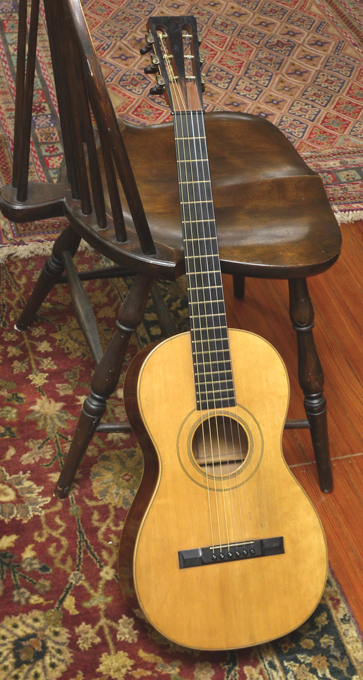 Circa 1860 parlor guitar style 1 built by well known luthier, James Ashborn of Wolcottville, CT, for William hall & son music store. Brazilian rosewood back and sides; Adirondack top; maple binding. This guitar is crack free save for a couple of minor finish cracks on back, and is 100% original, including all original finish, and down to original nut, original bridge (and saddle) that has never been off the guitar, and original bridge pins. From a just-published article in Vintage Guitar magazine: “Ashborn's design for the guitar was quite innovative for the early 19th century. Instead of making guitars fashioned after the typical parlor-style guitars, he made them in the Spanish style, by taking interior bracing cues from the Spanish while retaining the body of the English guitars. This included a fan brace pattern rather than the more common ladder pattern Ashborn guitars have a very complex dovetail V joint for attaching the head to the neck. The headstock was cut in roughly five steps, using some kind of tracing router, as suggested by the chatter marks on the inside ears of the pegbox. In addition to the complex head design, Ashborn made his own tuning machines in-house. They're made of brass, very much like contemporary machines, with worm gears, cog gears, and rollers. … Ashborn's shop was extremely advanced for its time, having a great deal of know-how and technology. Ashborn understood the need to have the technology as well as the skill, but more importantly he discovered a new way of making high-quality instruments that were affordable. He was able to create a factory environment where workers did what they were good at and, with practice, became very fast and consistent. With a new level of consistency in mass production, he created the path followed by other companies such as Martin, Gibson, and Taylor. Using designs ahead of his time, he was able to bring the sound and change to people who otherwise never would have been able to acquire an instrument of this quality.” This beautiful all-original and crack-free Ashborn guitar is one of the best-preserved examples in existence.
Circa 1860 parlor guitar style 1 built by well known luthier, James Ashborn of Wolcottville, CT, for William hall & son music store. Brazilian rosewood back and sides; Adirondack top; maple binding. This guitar is crack free save for a couple of minor finish cracks on back, and is 100% original, including all original finish, and down to original nut, original bridge (and saddle) that has never been off the guitar, and original bridge pins. From a just-published article in Vintage Guitar magazine: “Ashborn's design for the guitar was quite innovative for the early 19th century. Instead of making guitars fashioned after the typical parlor-style guitars, he made them in the Spanish style, by taking interior bracing cues from the Spanish while retaining the body of the English guitars. This included a fan brace pattern rather than the more common ladder pattern Ashborn guitars have a very complex dovetail V joint for attaching the head to the neck. The headstock was cut in roughly five steps, using some kind of tracing router, as suggested by the chatter marks on the inside ears of the pegbox. In addition to the complex head design, Ashborn made his own tuning machines in-house. They're made of brass, very much like contemporary machines, with worm gears, cog gears, and rollers. … Ashborn's shop was extremely advanced for its time, having a great deal of know-how and technology. Ashborn understood the need to have the technology as well as the skill, but more importantly he discovered a new way of making high-quality instruments that were affordable. He was able to create a factory environment where workers did what they were good at and, with practice, became very fast and consistent. With a new level of consistency in mass production, he created the path followed by other companies such as Martin, Gibson, and Taylor. Using designs ahead of his time, he was able to bring the sound and change to people who otherwise never would have been able to acquire an instrument of this quality.” This beautiful all-original and crack-free Ashborn guitar is one of the best-preserved examples in existence. -
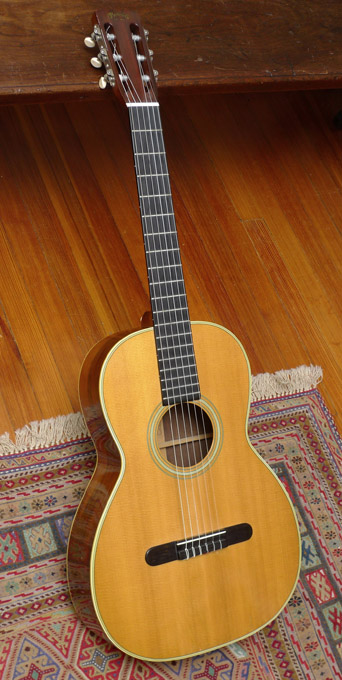 Another wonderful instrument with top grade Brazilian Rosewood back and sides. The Brazilian rosewood on this in instrument is more figured on the sides, and the back shows wonderful bookmatched figuring. This is an all-original guitar. There are no cracks that go through the wood. There are several finish/superficial cracks in the finish, one on the top near the bottom/endpin area, and one on the back. And a bit of crazing in the top finish. Set-up and playability is great. Wonderful full tonal range up and down the fretboard.
Another wonderful instrument with top grade Brazilian Rosewood back and sides. The Brazilian rosewood on this in instrument is more figured on the sides, and the back shows wonderful bookmatched figuring. This is an all-original guitar. There are no cracks that go through the wood. There are several finish/superficial cracks in the finish, one on the top near the bottom/endpin area, and one on the back. And a bit of crazing in the top finish. Set-up and playability is great. Wonderful full tonal range up and down the fretboard. -
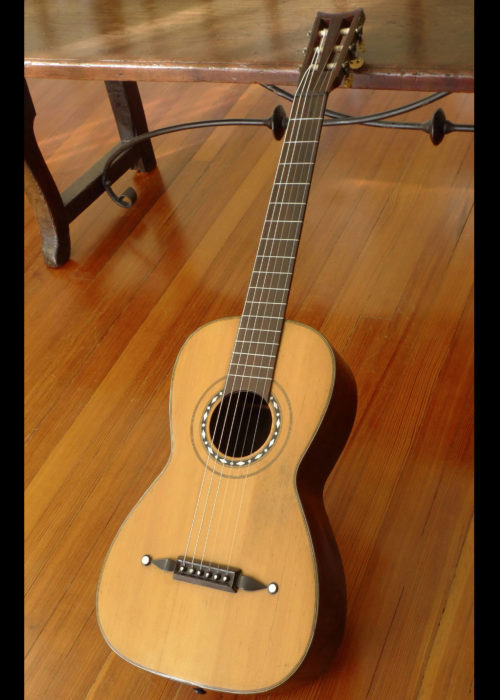 More rare than a Panormo guitar, this original, wonderfully preserved and sonorous guitar is from the London-based J. Guiot, circa 1846– and it’s a cousin if not a sibling of a Panormo, in style, appointments, and provenance. The headstock and neck volute of this instrument, as well as the bridge, exactly match that of two known Guiot guitars of the period (see links below). It’s possible that this guitar was made in the workshop of Panormo by Guiot while he worked there, and it is in fact Panormo in style, exactly– but likely it’s one of the very rare-on-the-market Guiot guitars made after Guiot established an independent workshop in the 1840’s. Either way, we guarantee it as a Guiot, and the value of Guiots– being very rare– are in line with Panormos. This guitar is in remarkable original condition, with none of the kinds of damage, major repairs, or structural issues found on nearly all surviving instruments of the period. And even more importantly, it plays wonderfully as well. We simply adjusted the nut a bit, and leveled the original frets, and it plays like it was recently made– but with a sound that only an 1840’s, London-made Spanish style guitar can produce. The intonation is great. Action is fine– not too high. Listen to the sound/video clip of this guitar being played, by clicking here. (Note: the video is labeled “Panormo” because the instrument was thought to be a Panormo when the recording was made. The guitar being played on the video is indeed this instrument). The guitar has a couple of repaired back cracks, and one well repaired top crack– amazingly little for a guitar this age. The features of this instrument: All original finish Spruce top Brazilian Rosewood back and sides Original Baker Tuners Original pin bridge, that has never been off the guitar Original frets Fan braced, 5 fan braces Scale length: 25 inches (63.5 cm) Lower bout: 11 3/8 inch (29.3 cm) Upper bout: 8 ¾ inches String spacing at bridge: 2 ½ inches Nut: 47 cm String spacing at nut: 1 ¾ inches Depth of sides (bottom): 4 inches (10cm) Depth of sides (top): 3 ½ Body length: 17 ¾ J. Guiot and A. Guiot were some of the luthiers who left France between 1830 and 1850, to work in London– and like Panormo, the Guiots made guitars in the Spanish style. Panormo had adopted a more Spanish style of guitar building in large part due to the urging of Fernando Sor– and that style that would soon overtake the French style, and eventually dominate in the new world as well (i.e. CF Martin’s adoption of the Spanish style of guitar making circa 1844 onward). The well known American composer and performer Madame Sydney Pratten was an ardent proponent of– and player of– the Guiot guitars in the mid-19th century. Reference: two Guiot instruments with the exact headstock and neck volute, and bridge (and also fret markers on 5, 7, and 9 position on the 1846 instrument): • Terz guitar, made by Guiot, Panormo model, London, made 1846– click here to view • J. Guiot, Panormo school guitar, made 1844 – click here to view. The instrument is in a modern hard shell case. Price: $6950.
More rare than a Panormo guitar, this original, wonderfully preserved and sonorous guitar is from the London-based J. Guiot, circa 1846– and it’s a cousin if not a sibling of a Panormo, in style, appointments, and provenance. The headstock and neck volute of this instrument, as well as the bridge, exactly match that of two known Guiot guitars of the period (see links below). It’s possible that this guitar was made in the workshop of Panormo by Guiot while he worked there, and it is in fact Panormo in style, exactly– but likely it’s one of the very rare-on-the-market Guiot guitars made after Guiot established an independent workshop in the 1840’s. Either way, we guarantee it as a Guiot, and the value of Guiots– being very rare– are in line with Panormos. This guitar is in remarkable original condition, with none of the kinds of damage, major repairs, or structural issues found on nearly all surviving instruments of the period. And even more importantly, it plays wonderfully as well. We simply adjusted the nut a bit, and leveled the original frets, and it plays like it was recently made– but with a sound that only an 1840’s, London-made Spanish style guitar can produce. The intonation is great. Action is fine– not too high. Listen to the sound/video clip of this guitar being played, by clicking here. (Note: the video is labeled “Panormo” because the instrument was thought to be a Panormo when the recording was made. The guitar being played on the video is indeed this instrument). The guitar has a couple of repaired back cracks, and one well repaired top crack– amazingly little for a guitar this age. The features of this instrument: All original finish Spruce top Brazilian Rosewood back and sides Original Baker Tuners Original pin bridge, that has never been off the guitar Original frets Fan braced, 5 fan braces Scale length: 25 inches (63.5 cm) Lower bout: 11 3/8 inch (29.3 cm) Upper bout: 8 ¾ inches String spacing at bridge: 2 ½ inches Nut: 47 cm String spacing at nut: 1 ¾ inches Depth of sides (bottom): 4 inches (10cm) Depth of sides (top): 3 ½ Body length: 17 ¾ J. Guiot and A. Guiot were some of the luthiers who left France between 1830 and 1850, to work in London– and like Panormo, the Guiots made guitars in the Spanish style. Panormo had adopted a more Spanish style of guitar building in large part due to the urging of Fernando Sor– and that style that would soon overtake the French style, and eventually dominate in the new world as well (i.e. CF Martin’s adoption of the Spanish style of guitar making circa 1844 onward). The well known American composer and performer Madame Sydney Pratten was an ardent proponent of– and player of– the Guiot guitars in the mid-19th century. Reference: two Guiot instruments with the exact headstock and neck volute, and bridge (and also fret markers on 5, 7, and 9 position on the 1846 instrument): • Terz guitar, made by Guiot, Panormo model, London, made 1846– click here to view • J. Guiot, Panormo school guitar, made 1844 – click here to view. The instrument is in a modern hard shell case. Price: $6950. -
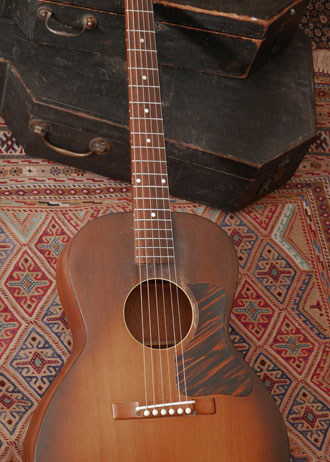 Read the full description below. If you're interested in this guitar, please call 512.922.8596 or contact us here.
Read the full description below. If you're interested in this guitar, please call 512.922.8596 or contact us here.